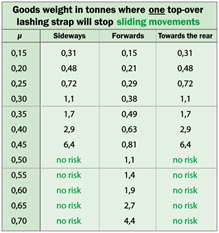Safe Strapping: Ian Responds to Your Feedback
After our recent driver insight video sparked debate online, Ian takes a closer look at safe and legal load securing practices – explaining the reasoning behind his technique and the regulations that guide it.
I have put together some thoughts on the strapping comments we received on one of our recent videos.
Firstly, thank you for the comments - any form discussion or feedback is welcomed I am always open to it. Below are two sections, the first deals with whether the strapping system is safe and legal or DVSA standards using the EN12642 L – International Guidelines on Safe Load Securing for Road Transport. The second is discussing whether two straps is better on this specific type of load.
Safe Loading Guidelines
Remember that safe loading is all about creating enough friction between the load and the bed of the lorry to prevent 100% forward and 50% sideways and backwards movement.
The regulations and science are very precise about how to calculate this, it may surprise you to note that it is possible to design a safe flat bed loading system that requires no strapping at all and is still be safe and legal, although putting a strap over this load would prevent being pulled over and being asked the lengthy questions to prove it!
In this case, we are using the headboard on the swan neck plus a secondary headboard within the design of the step frame trailer to stop 100% of the forward movement for the majority of the load. This is combined with block loading beyond the step frame leaves only the top layer of pallets at the front that rely on separate load restraint to prevent forward movement.
For each banded pallet of panels above the headboard, using a pull down style ratchet straps (SHF so a high and easily consistent “standard hand force”) with a lashing capacity of 2,500 daN (2500kg) to force down the top pallet down onto the pallet below (2 rough sawn timber surfaces, so a high coefficient of friction 0.45), using the table below we can see that one ‘Top Over’ strap is enough to stop 0.81 tonnes sliding forward and 6.4 tonnes sideways and backwards.
Ref: EN 12642 L Safe loading Regulations

So if a well maintained undamaged strap is correctly used, then we are within legal safety limits for Lorry Loading. Overall this is a sign of a well selected and designed loading system which includes the trailer design and construction and the correctly selected ratchet strap rating and pulldown handle design.
The more straps we use the better right? ….
The answer is not always that clearcut, for many loads this is absolutely true you can add extra straps to add more redundancy should a strap fail.
In this case, the load is a stack of roughsawn not necessarily even/flat timber built into fence panels that has the potential to settle and change shape as the load Bounces and jiggles in transport. Not to mention potential expansion and contraction to water gain or loss (sun and rain). So it can change shape across the pallet area feasibly changing the stack height differently on different parts of the load area/surface.
First and foremost when carrying this kind of load you will absolutely need to stop more often to check and possibly retension as a matter of course, after about half an hour is very important, because of this settling effect. Maintaining regular mirror checks on the state of your straps should also become second nature with these style of loads.
When adding an extra strap for redundancy, this creates a potential risk of ‘uneven’ tensioning from the start or becoming uneven during transit, if one of the two straps is looser (or becomes looser during transit due to road bounce and/or settle) the other strap on the same pallet will often also become looser at the same time (one side of the pallet will spring up under the loosening strap causing the other side of the pallet to settle downwards). So typically you will have two loose straps that could potentially come off the lorry into the carriageway instead of one.
If you do decide to use 2 straps then be careful that you use even tension to begin with, the tensioners (ratchets) for each pack should be on alternate sides of the lorry/load for each unit being strapped. As when strapping with a 90 degree angle over the corners this creates friction and can cause the tension to be different on different sides of the load, this is exacerbated if the ratchets are both on the same side. To prevent this once tensioned it is important to check and put weight on the other side to ensure strap has even tension both sides. Using smooth corner protectors can mitigate this problem allowing the strap to slide over corners evenly, this is also why you need to stop and check strap tension relatively soon in your journey as normal load ‘bounce’ will naturally even this unevenness of tension out, potentially requiring re tensioning because of this.
You can view the original video on the various platforms linked below:
Google Reviews
-
 Dave GallacherGood range of jobs available, decent rates of pay. Always able to get in contact with the office or someone on call with good knowledge and understanding of the job or role sent to. Never had an issue with pay, easy timesheet process
Dave GallacherGood range of jobs available, decent rates of pay. Always able to get in contact with the office or someone on call with good knowledge and understanding of the job or role sent to. Never had an issue with pay, easy timesheet process -
(1).png?r=a2-s120.120-o) Ionel Lucian DinicaVery easy to find work , very nice and kind staff, all details explained very easy. Highly recommended.
Ionel Lucian DinicaVery easy to find work , very nice and kind staff, all details explained very easy. Highly recommended. -
 Catalin SirgheA reliable and efficient agency. I’ve had a positive experience with Driver Require. They have consistently paid on time and have never cancelled a shift. The communication is excellent. If you’re looking for a reliable agency that values its drivers, Driver Require is a great choice.
Catalin SirgheA reliable and efficient agency. I’ve had a positive experience with Driver Require. They have consistently paid on time and have never cancelled a shift. The communication is excellent. If you’re looking for a reliable agency that values its drivers, Driver Require is a great choice.
